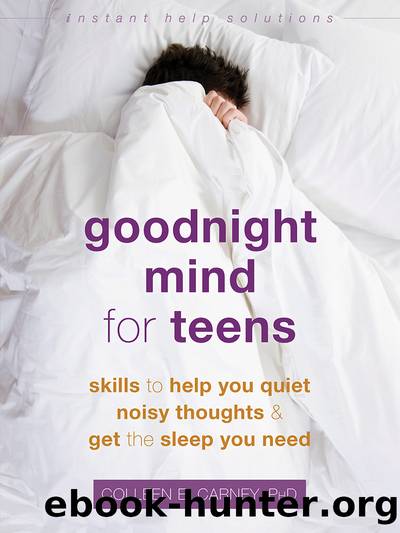Goodnight Mind for Teens by Colleen E. Carney

Author:Colleen E. Carney
Language: eng
Format: epub
Tags: teen insomnia;cognitive behavioral therapy;cbt;goodnight mind;circadian rhythm
Publisher: New Harbinger Publications
Published: 2020-05-08T20:45:28+00:00
âSleepyâ Sleep Disorders
Sleepiness can also result from having an undetected sleep disorder. Below are descriptions of sleep disorders associated with sleepiness. If you continue to suffer from sleepiness after implementing the changes in this chapter, or if you can recognize some of the symptoms below in you, talk to your family doctor.
Sleep Apnea
Obstructive sleep apnea is a breathing disorder that occurs during sleep. If you have sleep apnea, you stop breathing for 10 seconds or more many times per hour, every night. While you stop breathing, your brain and the rest of your body are deprived of oxygen. Possible factors for sleep apnea include: (1) loud, nightly snoring, (2) sleepiness, (3) high blood pressure, (4) someone observing you stop breathing while you sleep, (5) a large neck (a neck size of 17 inches or larger for a male, 16 inches or greater for a female), (6) being significantly overweight, and (7) being male. Although sleep apnea is far more common during middle age and older, it is possible to have sleep apnea even as a child. Sleep apnea is very dangerous if left untreated, and it is easily treated with breathing-assistance devices that keep the airway open as you sleep.
Periodic Limb Movement Disorder
Periodic limb movement disorder (PLMD) is a neurological disorder in which the leg twitches, and it creates poor quality sleep. You are probably unaware of the twitches, but if someone has seen your leg twitching and you are sleepy, you should talk to your family doctor. If you have something called restless leg syndrome (RLS), a disorder in which you experience a strong urge to move your legs when at rest in the evening, and you are sleepy, you may want to talk to your family doctor about assessing for PLMD with a night at a sleep lab. Not everyone with RLS has PLMD, but they frequently occur together. RLS and PLMD are treated with medications.
Narcolepsy
Narcolepsy is a neurological disorder in which rapid eye movement (REM) sleep intrudes into wakefulness. Narcolepsy can look differently in different people. Some of the symptoms include (1) âsleep attacks,â that is, falling asleep unintentionally throughout the day; (2) cataplexy; (3) hallucinations upon falling asleep or waking up; (4) sleep paralysis; and (5) excessive daytime sleepiness. However, not all of these symptoms have to be present, so narcolepsy can vary from person to person. Cataplexy is a loss of muscle tone in response to something emotional. The loss of tone may result in total collapse onto the floor or a mild buckling of the legs such that the person cannot continue to stand. The head and jaw often slump forward and the arms often collapse to their sides. Common emotional triggers include laughing, being frightened, or being angered. People affected by cataplexy remain aware throughout the attack, which can frighten them and leave them vulnerable to prolonged symptoms. Sleep paralysis is a symptom of narcolepsy (although it can also appear on its own) in which you wake up and briefly are unable to move.
Download
This site does not store any files on its server. We only index and link to content provided by other sites. Please contact the content providers to delete copyright contents if any and email us, we'll remove relevant links or contents immediately.
Harry Potter: A Journey Through a History of Magic by British Library(368)
The Science of Philip Pullman's His Dark Materials by Mary Gribbin(343)
The Basics of Organic Chemistry by Clowes Martin;(342)
Harry Potter and the Sorcerer's Stone: SparkNotes Literature Guide by SparkNotes(305)
Flowers in the Gutter by K. R. Gaddy(272)
Braiding Sweetgrass for Young Adults by Robin Wall Kimmerer(266)
Super Simple Chemistry by D.K. Publishing(262)
Summary of the Selfish Gene by Readtrepreneur Publishing(259)
Exam Success in Geography for IGCSE & O Level by Unknown(258)
JavaScript Coding for Teens: A Beginner's Guide to Developing Websites and Games by Yueh Andrew(251)
Dark days in Salem: the witchcraft trials by Deborah Kent(244)
The Python Audio Cookbook;Recipes for Audio Scripting with Python by Alexandros Drymonitis(240)
Analysis and Linear Algebra for Finance: Part II by Bookboon.com(236)
Key Immigration Laws by Kathryn Ohnaka(229)
Cracking the AP Economics Macro & Micro Exams, 2017 Edition by Princeton Review(225)
Solutions for a Cleaner, Greener Planet: Environmental Chemistry by Marc Zimmer(215)
The Science of Fashion by Julie Danneberg;(212)
Reverse Engineering For Everyone! by mytechnotalent(203)
Cracking the AP Psychology Exam, 2017 Edition by Princeton Review(199)
